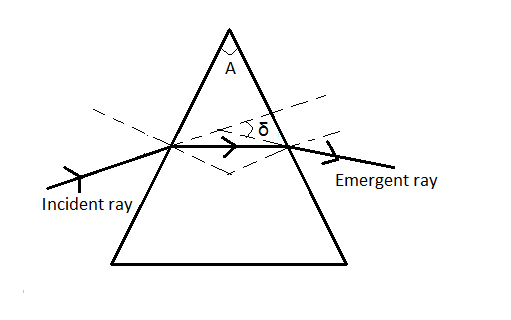
(a) Define prism angle and angle of deviation for a prism.
(b) Write the sequence of colors in the spectrum formed by the passage of white light through a prism.
(c) Explain the process of formation of a rainbow.
Answer
570.9k+ views
Hint: The angle of deviation and the angle of a prism are related to each other. The angle of deviation gives the measure of how deviating a prism when light of different colors passes through it. Different colors are deviated by different angles.
Complete step by step answer:
The prism angle or refracting angle of a prism is the angle made by the two refracting faces of the prism with each other. For an equilateral prism, this refracting angle of the prism angle is equal to ${{60}^{0}}$.
The angle of deviation of a prism is the angle made by the incident ray extended forward and the emergent ray extended backward. A diagram will make things clearer.

For this prism, the angle of the prism is $A$ and the angle of deviation is $\delta $.
(b) When white light passes through a prism, the sequence of colors obtained in the spectrum is red, orange, yellow, green, blue, indigo, violet from top to bottom, that is, red is least deviated while violet is most deviated and approaches to the base of the prism. This order can be memorized in the reverse form by the mnemonic “VIBGYOR” where each letter stands for the colors in the reverse sequence.
(c) A rainbow is formed when rainfall occurs while the sun is still out. The white light rays of the sun enter little rain water droplets and are split up into their component colors similar to how a prism splits white light. The rays are internally reflected by the inner surface of the water droplet and the dispersed light rays exit the rainwater droplet having been split up into the seven component colors and form a beautiful rainbow.

Note:
Students should not confuse the angle of emergence with the angle of deviation, thought the concepts might seem similar. The angle of emergence is the angle made by the emergent ray with the normal on the surface from which the emergent ray emerges whereas the deviation angle is the angle made by the emergent ray produced backward and the incident ray produced forward. Thus, the angle of deviation is the actual representation of how much the light ray gets deviated from its original path (which it would follow in the absence of the prism) due to the presence of the prism and the angle of emergence does not give information about this.
Complete step by step answer:
The prism angle or refracting angle of a prism is the angle made by the two refracting faces of the prism with each other. For an equilateral prism, this refracting angle of the prism angle is equal to ${{60}^{0}}$.
The angle of deviation of a prism is the angle made by the incident ray extended forward and the emergent ray extended backward. A diagram will make things clearer.

For this prism, the angle of the prism is $A$ and the angle of deviation is $\delta $.
(b) When white light passes through a prism, the sequence of colors obtained in the spectrum is red, orange, yellow, green, blue, indigo, violet from top to bottom, that is, red is least deviated while violet is most deviated and approaches to the base of the prism. This order can be memorized in the reverse form by the mnemonic “VIBGYOR” where each letter stands for the colors in the reverse sequence.
(c) A rainbow is formed when rainfall occurs while the sun is still out. The white light rays of the sun enter little rain water droplets and are split up into their component colors similar to how a prism splits white light. The rays are internally reflected by the inner surface of the water droplet and the dispersed light rays exit the rainwater droplet having been split up into the seven component colors and form a beautiful rainbow.

Note:
Students should not confuse the angle of emergence with the angle of deviation, thought the concepts might seem similar. The angle of emergence is the angle made by the emergent ray with the normal on the surface from which the emergent ray emerges whereas the deviation angle is the angle made by the emergent ray produced backward and the incident ray produced forward. Thus, the angle of deviation is the actual representation of how much the light ray gets deviated from its original path (which it would follow in the absence of the prism) due to the presence of the prism and the angle of emergence does not give information about this.
Recently Updated Pages
A man running at a speed 5 ms is viewed in the side class 12 physics CBSE

The number of solutions in x in 02pi for which sqrt class 12 maths CBSE

State and explain Hardy Weinbergs Principle class 12 biology CBSE

Write any two methods of preparation of phenol Give class 12 chemistry CBSE

Which of the following statements is wrong a Amnion class 12 biology CBSE

Differentiate between action potential and resting class 12 biology CBSE

Trending doubts
What are the major means of transport Explain each class 12 social science CBSE

Which are the Top 10 Largest Countries of the World?

Draw a labelled sketch of the human eye class 12 physics CBSE

How much time does it take to bleed after eating p class 12 biology CBSE

Explain sex determination in humans with line diag class 12 biology CBSE

Explain sex determination in humans with the help of class 12 biology CBSE




